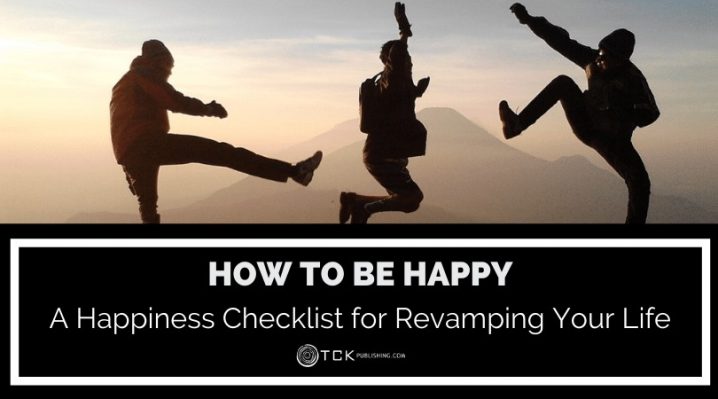
You might think that if you got what you wanted in life, you’d be happy. But research shows that’s not how happiness works. In fact, people who obsessively chase the next goal in life often remain unhappy and unfulfilled, on what scientists call “the hedonic treadmill.”
Happiness takes practice and work. Each of us has to find our own journey in life, and life is often hard. Sometimes you’ll be scared, in pain, and lost. But happiness is what you get when you learn to journey well through all the struggles and successes in life.
How to Be Happy: The Theory
According to authentic happiness theory, humans needs three things to be happy: positive emotions, engagement, and meaning.
1. Positive emotions
Positive emotions include pleasant or desirable experiences, which can be as simple as eating ice cream or as complex as feeling a deep sense of compassion toward another person who is suffering (which might make you feel contentment because you were able to comfort a friend in pain).
Positive emotions include joy, optimism, and contentment. Most people think happiness and joy are the same thing, but they’re not. You need some joy in your life to be happy, but joy alone will never make you truly happy long-term.
2. Engagement
Engagement means being deeply involved and absorbed in a task. This is when you are so invested and enraptured by what you’re doing that you lose track of time.
You’ll feel most engaged when you find flow through play, work, and daily life. Find things that you love to do, whether it’s a new hobby, challenging work, or having deep conversations with friends.
3. Meaning and Purpose
Meaning comes when you do something for other people or causes beyond yourself like raising children, starting a community garden with your neighbors, or joining a local band.
If you feel like something is missing, chances are you need to put effort into cultivating these three keys to happiness.
Happiness Checklist
You can download the TCK Happiness Checklist here. You can print it out and put it on your wall as a daily reminder to practice these new habits that will help you develop more positive emotion, engagement, and meaning in life.
How to Cultivate Positive Emotions

1. Create a gratitude journal.
Many studies suggest that gratitude makes you happier and rewires your brain positively. The more you practice gratitude, the better you’ll get at it. Gratitude is a habit that anyone can develop.
You can check out our post for some ideas on how to start your gratitude journal, but feel free to explore other techniques that work for you. The point is practice feeling grateful every day.
2. Praise someone.
In Big Potential, Shawn Achor explains, “The more praise you give, the more praise you will deserve and receive.”
Take a minute or two each day to write a text, letter, or note to offer genuine praise. If your coworker is doing something you find praiseworthy, never hesitate to say it. At first it might feel really awkward, but you’ll be pleasantly surprised by how good it will make you and them feel.
Offering praise to others improves their motivation and performance, and also makes it more likely that they will praise you back. Instead of a culture of complaints and negativity, you can help create an environment where everyone feels respected and valued.
Once you begin to practice noticing praiseworthy behavior, you’ll find it everywhere—at work, at home, and out in public with complete strangers.
3. Perform a kind act.
Do something kind for others today. Provide a free service for your loved ones. Share your food. Offer help to your coworker. Donate your unused stuff to those in need. Volunteer for a nonprofit organization and help the community.
You’ll be rewarded for your kindness—not only by others, but by your brain as well.
4. Meditate.
Look for a meditation practice that works for you and schedule time in your calendar to practice it daily.
Practicing meditation and mindfulness makes you happier according to research. They also increase your daily experience of positive emotions, which in turn reduces depression and increases life satisfaction.
5. Identify the noise, then eliminate it by at least 5%.
Noise is any information or experience that is not necessary, useful, or fulfilling for you and that you can reasonably eliminate from your life like binging Netflix or browsing social media endlessly.
In Shawn Achor’s book Before Happiness, he defines four criteria to help you identify noise in your life:
Unusable: Your behavior will not be altered by the information (like watching pharmaceutical ads on TV).
Untimely: You are not going to use that information immediately, and it could change by the time you use it (if you’re not going to buy or sell bitcoin today, then checking the price is untimely).
Hypothetical: It is based on what someone believes “could be” instead of “what is” (like gossiping and sharing opinions about how other people should behave).
Distracting: It distracts you from your goals (like browsing social media when you’re trying to write an article).
There’s some noise in life that you just can’t control, and you shouldn’t worry about that. But there are probably sources of noise in your life that you could limit or eliminate so you could focus more energy and time on things that actually matter to you.
Eliminating noise does not mean blocking all negativity from your life; it means getting rid of what is irrelevant, unhelpful, and even harmful.
Reduce your social media consumption because it is often a source of distress and anxiety. There can be some great benefits of using social media to connect with new and old friends, but there’s a dark side to social media too. Be careful not to spend too much time on social media when it’s not actually helping you connect with people or achieve your goals.
Here are some more practical steps to help you reduce the noise in your life:
- Remove social media apps from your phone. You can still use them on your desktop or phone browser, but this tip might help you change any bad social media habits you have.
- Write down a list of your priorities (everything from professional to social) so you know when a piece of information is unusable or untimely. If something is unrelated to your projects, responsibilities, or goals, it might be noise.
- Put your phone away at least two hours before going to sleep. Not only will this cut the noise, but it will also improve your sleep quality.
- Mute the audio in your car for 15 minutes before playing anything or listening to the radio.
- Spend less time watching TV or Netflix.
- Do a digital detox day once a week. Take a break from your phone or any digital devices and go outside.
- Write a “Quit” list. You’re probably already doing something that adds significant noise in your life. Use the four criteria above and eliminate what’s on the list as thoroughly as possible.
- Set up your technology to avoid distractions:
- Use the “Do Not Disturb” or “Focus Mode” feature on your phone when working, so you don’t get unnecessary or distracting notifications.
- Delete games from your phone. You can always download them again when you really want (and have the time) to play. This slight change will help inhibit your impulse to play.
- Use Facebook Feed Eradicator so you don’t see a newsfeed when you open Facebook. Your newsfeed is designed to make you stay there and keep scrolling. If you ever intended to quickly check Facebook, then looked up two hours later, you know what I’m talking about.
- Block websites that lead to mindless browsing (you can always enable them when you aren’t working).
- Use Unroll.me to unsubscribe from unnecessary emails. Anything irrelevant is noise.
- Use Gmail filters to clear your inbox clutter and remove any repetitive emails that you don’t need to see again.
Be Engaged

1. Identify your signature strengths.
Identifying your signature strengths will help you have a lot more fun, success, and meaning in life.
Strengths are not skills. Programming is a skill, and anyone can learn it. Strengths are personality traits that we all have to lesser or greater degrees (and which can be developed and modified over our lives).
For example, one of my strengths is my love of learning. So I looked for a job where I could spend most of my time researching and learning new things.
You can find your signature strengths in this 15-minute questionnaire. Upon completion, you’ll get a ranked list of your signature strengths with your core strength at the top.
Once you know what your strengths are, then you can find ways to modify your work and personal life that allow you to spend more time using your strengths, which will make life a lot easier and more enjoyable for you.
2. List your flow activities and identify your flow profile.
Recall a time when you found yourself lost in enjoyment, and hours seemed to fly by while you were doing something. Maybe it was when you began playing basketball and suddenly realized the fourth quarter was over so quickly, or when you began writing your article in the morning and noticed that it’s lunch time already.
According to the Flow Genome Project, there are four different flow types: the deep thinker, the crowd pleaser, the hard goer, and the flow goer. You can take the test to find out your Flow profile here. It’s a short quiz that you can complete in as little as 3 minutes. Upon completion, you will receive recommendations on how you can add flow activities to your life based on your flow type.
Identifying your flow type will help you complement it with your signature strengths so you can stack together what you’re good at and what engages you deeply.
3. Design your life around flow activities.
Once you’ve found what makes you tick, the next step is to design your life around those activities. Either make it a hobby that you engage in often, or choose a career that revolves around those activities.
If you enjoy writing, work as a novelist, blogger, or copywriter. If you like yoga, then try to earn an instructor certificate and share your passion with the world. If you love socializing, participate in social or political causes, become an influencer, or play a group sport.
If you’re looking for a career where you are more likely to excel and be the best, look at your highest flow activities and find a job that allows you to engage in them more often.
Flow and high performance are a package deal; where there is flow, excellence follows. When you experience flow, mental and physical performance go through the roof. In fact, a 10-year study by McKinsey shows that business executives who have more access to flow at work are 500% more productive than their non-flow peers.
By not accessing your flow, you are losing out to your top competitors. The person in flow has achieved on Monday what you would’ve achieved in a whole week. Imagine how much more you could achieve in life with 5x more productivity!
Take a moment and think seriously about how you spend your time. The quality of your life hangs in the balance. You’ll have a more engaged life and better career over the years if you can set yourself up to experience more flow.
Note: It is possible to have more than one flow profile, and it is also possible to learn or adopt the others. Pursuing a path that isn’t your main flow profile is not necessarily wrong; the point is to do more of your highest flow activities.
Find Meaning and Purpose
You can eat the finest food in the world, meditate all day long, or play chess by yourself and puzzle about the infinite possibilities of a 64-square board, but none of this is enough to be happy unless you share your life with others. Flow is great, but there’s more to life.
Do you want to live a happy, but meaningless life? That sounds like a contradiction—because it is. If you only think of happiness as an individual pursuit, you are doomed to fail. It’s not all about you.
One of the most interesting investigations of life’s meaning that I’ve found comes from a show called Rick and Morty, where even the smartest scientist in the multi-verse cannot seem to find an answer to the meaning of life.
While I will not recommend the exact things you must do to find meaning in your life, there are certain questions that you need to answer in order to discover it yourself: who, what, and why.
Who do you want to serve? What service will you provide to them? Why?
I leave it up to you to figure out what gives you meaning. There’s no right or wrong answer, and this is not the only way to find meaning. But once you’ve found it, after all the searching, testing, and experimenting… make a decision to commit your life to it.
Commit yourself to this worthy cause you have chosen. Serve your “who” with the best possible “what” you can provide.
And your “why”? Let it serve as your fuel. It will be a long and winding road ahead and you’ll need to remind yourself when things get tough why this challenging road you’ve chosen is so important to you.
Achieving Happiness
To live your life only looking for ways to feel good is to live only with positive emotions. That’s not how life works (because you will feel “negative” emotions), and even if it was, it’s not enough to be truly happy.
You must also be engaged. You must find meaning and purpose. Being truly engaged means you’ll have to do difficult things—you’ll have to go to training even though you want to sleep more; you’ll have to do the same thing again and again so you don’t mess up in the big game; you’ll have to play against better opponents and get your butt kicked just to get better at whatever you have chosen.
And the same goes for finding meaning and purpose. When you do things bigger than yourself, you will inevitably face challenges that you otherwise wouldn’t have to face. It might mean making sacrifices, like spending less time watching TV, partying with friends, and doing the easy and comfortable things. You’ll have to give up the things holding you back from fully serving and contributing to whatever gives you meaning.
The road to happiness is fraught with discomfort and difficulties, but the meaning you find, the strengths you develop, and the flow activities you enjoy will make it all worthwhile. When challenges arise—and surely they will—remember the words of Baruch Spinoza: “Everything excellent is as difficult as it is rare.”
Did you find this post helpful? Let us know in the comments below!
If you enjoyed this post, then you might also like:
- 5 Steps to Dealing with Toxic and Negative People so You Can Be Happy and Do Good Work
- 7 Unexpected Habits of Happy People
- 10 Best Self-Help Books for Improving Your Health, Happiness, and Relationships
- 8 Best Journal Apps to Track Your Gratitude, Health, and Memories
Rutherford Rigodon is a psychometrician-turned-marketer who loves reading and writing about human psychology and all its implications in human life. As the Digital Marketer for TCK Publishing, he creates and executes the marketing campaigns to ensure that TCK’s books get to the hands of our beloved audience at the right place and at the right time.
